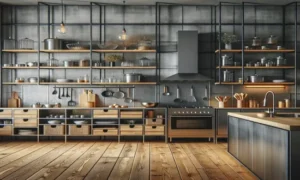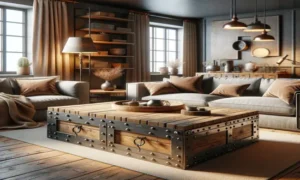Introduction
Industrial furniture has emerged as an influential trend in modern design, characterized by its robustness, functionality and striking aesthetics. Originally inspired by the factories and industrial environments of the early 20th century, this style incorporates a variety of materials that are chosen for both their durability and their ability to create a visually striking and comfortable environment. The diversity of these materials allows designers and manufacturers to create unique pieces that stand out for their robustness and aesthetic appeal. Materials such as wood, metal, glass and plastic are commonly used, each bringing their own unique advantages and characteristics. These pieces of furniture are not only functional, but also works of art, combining practicality with a design that makes a strong and authentic statement in the modern environment.
Madeira: The Classic Reinvented
Wood is one of the most classic and versatile materials in the manufacture of industrial furniture, offering a perfect combination of durability and aesthetics. The most common types include pine, known for its strength and ease of work; oak, famous for its robustness and distinctive grain pattern; and mahogany, appreciated for its color.
ica and exceptional durability. Each type of wood brings its own nuances and characteristics, allowing for a wide range of applications and designs.
Wood is prized for its durability, standing the test of time in terms of both strength and style. The natural aesthetic of wood, with its varied grain patterns and colors, adds a dimension of warmth and authenticity that is difficult to replicate with other materials. Its versatility is also notable, allowing it to be crafted into a variety of shapes and finishes, adapting to different styles, from rustic to modern.
In industrial furniture, wood is often used for sturdy tables, wide shelves and worktops, where its solidity is valued as much as its aesthetics. It can be combined with metal for a textural contrast, or used purely to create pieces that highlight the material’s natural beauty. For example, an oak coffee table can serve as a centerpiece in an industrial space, while pine shelving can provide a practical and visually pleasing storage solution. In industrial settings, wood is not only a practical choice, but also a design element that brings warmth, history and an organic connection to nature.
Metal: Resistance and Modern Style
Metal, a key element in the manufacture of industrial furniture, is synonymous with strength and modern style. Among the most commonly used metals are steel, aluminum and wrought iron. Steel is valued for its robustness and ability to support significant weights, making it ideal for tables, chairs and cabinets. Aluminum, on the other hand, is lightweight and corrosion-resistant, often chosen for furniture that needs to be movable or for outdoor use. Wrought iron, on the other hand, is appreciated for its versatility in decorative designs, especially in ornamental details.
In the context of industrial aesthetics, metal is a protagonist. It not only provides a sense of solidity and permanence, but also adds a touch of modernity and sophistication. Whether in polished, brushed or corten steel finishes, metal is capable of transforming the environment, bringing with it a sense of refinement and strength.
Caring for and maintaining metal furniture is relatively simple, but crucial to ensuring its longevity. It is important to protect the surfaces from scratches and corrosion by regularly cleaning with suitable products and avoiding prolonged exposure to humidity and extremely saline environments. In addition, periodic application of protectors or repainting may be necessary to maintain the appearance and integrity of the material.
Plastic: Lightness and Variety
Plastic is an increasingly popular material in the manufacture of industrial furniture, standing out for its lightness and wide variety. The most common types include polyethylene, PVC and acrylic. Polyethylene is appreciated for its strength and flexibility, while PVC is known for its durability and ease of maintenance. Acrylic, on the other hand, offers a more refined aesthetic and is often used in pieces that seek a more modern and minimalist look.
The cost-effectiveness of plastic furniture is one of its biggest attractions. In addition to being more affordable, it is durable, lightweight and easy to clean, making it an excellent choice for industrial environments, where practicality is as important as design. It is especially popular in spaces that require movable furniture or that are subject to varying environmental conditions, such as humidity and heat.
In industrial interior design, plastic is often used for chairs, side tables and decorative elements. In some cases, it is combined with other materials, such as metal or wood, to create an interesting contrast and add an extra layer of sophistication to the space. For example, polyethylene chairs can be used in conjunction with a sturdy wooden table, creating a visual balance between traditional and modern.
Glass: Elegance and Transparency
Glass, with its elegance and transparency, brings a unique dimension to industrial furniture. The most commonly used types of glass in furniture are tempered and laminated glass. Tempered glass is known for its exceptional resistance to impacts and temperature variations, making it a safe choice for tabletops and shelves. Laminated glass, on the other hand, has a safety layer that keeps the material intact even when broken, offering an even safer solution.
Combining glass with other materials is a common practice in industrial furniture design. For example, a table with a tempered glass top and a forged metal base is not only visually striking, but also extremely durable. Glass is also often used with wood, creating a contrast between the natural and the manufactured, softening the industrial aesthetic with its lightness and transparency.
In terms of safety and durability, industrial furniture that incorporates glass is designed to withstand daily use and wear and tear. Proper treatment of the glass, such as polished edges and appropriate thicknesses, ensures that it can be used safely in any environment, from offices to industrial kitchens, maintaining its beauty and integrity over time.
Composite Materials and Innovations
Composite materials such as MDF (Medium-Density Fiberboard) and laminates are gaining popularity in industrial furniture manufacturing. MDF, for example, is an engineered wood product that offers excellent strength and ease of manipulation, allowing for the creation of complex and detailed designs. Laminates, on the other hand, are known for their variety of finishes and durability, and are often used to cover furniture surfaces, providing an attractive appearance with minimal maintenance.
Technological innovations are continually transforming the materials used in industrial furniture. New manufacturing processes, such as 3D printing and the use of recycled materials, are opening the door to more personalized and sustainable designs. These technologies not only expand aesthetic possibilities, but also promote more responsible practices in line with growing environmental concerns.
Looking ahead, the industrial furniture industry can be expected to continue to evolve, incorporating increasingly innovative and sustainable materials. The use of advanced composites and emerging technologies promises to take furniture design to new heights, combining functionality, aesthetics and environmental responsibility in ways previously unimaginable.
Practical Applications in Domestic Environments
Industrial furniture, with its robust and stylish character, can be incorporated into many rooms of a home in surprising ways, creating a contemporary and welcoming ambiance. In the kitchen, for example, open shelves made of metal and wood provide practical and aesthetically pleasing storage, while stainless steel countertops evoke a professional kitchen feel. In living rooms, a sturdy wooden coffee table or a sofa with metal accents can serve as focal points, combining functionality with striking design.


In bedrooms, incorporating industrial furniture can come in the form of metal headboards or wooden cabinets with metal accents, providing an interesting contrast with soft fabrics and warm colors. Even in bathrooms, industrial elements such as sinks mounted on metal frames or cabinets with metal finishes can add a touch of sophistication.


When it comes to combining with other styles, balance is key. Industrial furniture pairs well with natural elements like plants or natural fabrics, softening the look. Mixing in vintage or rustic pieces can also create a cozy ambiance, while adding bright colors or modern art can bring dynamism and warmth to a space. The beauty of industrial design is its versatility, allowing you to create unique spaces that reflect your personality and lifestyle.
Conclusion
Choosing the right material is crucial to the functionality and aesthetics of industrial furniture. Each material, whether wood, metal, plastic, glass or composite materials, brings its own unique qualities to the table. We encourage readers to explore the vast array of options available, combining durability, style and innovation. By choosing wisely, you can create spaces that not only look great but also stand the test of time.
